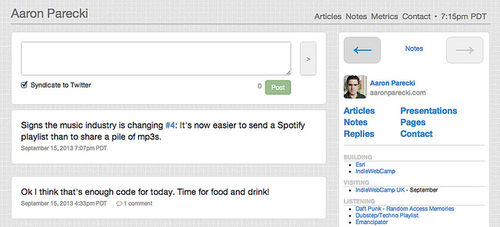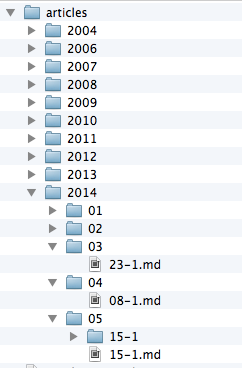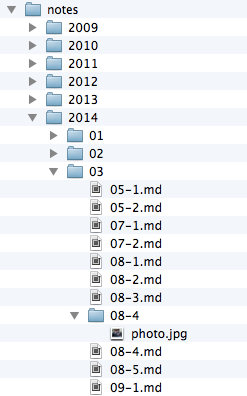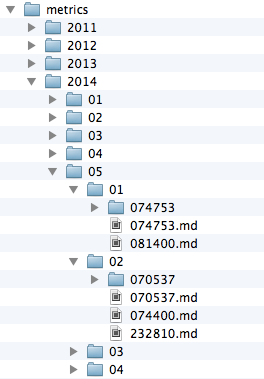p3k-v1
This article is a stub. You can help the IndieWeb wiki by expanding it.

pзk
pзk (pronounced "peek") is the name of the software that runs aaronparecki.com and indiewebcat.com. Below is the description of version 1 which was active until 2016-01-30. See p3k for information on the current version.
Screenshots




p3k event
Other
Source Code
While the core of p3k is not open source, many components are. Below is a list of the components used in p3k.
- Quill - note posting interface (https://github.com/aaronpk/Quill)
- php-mf2 - a PHP Microformats 2 parser
- mention-client-php - A PHP client to send webmentions and pingbacks
- Timezone-API - An API to find the timezone at a latitude and longitude
- php-comments - Helper for parsing and presenting comments from external sites
- link-rel-parser-php - Parse HTTP
Linkheaders into a structured format - indieauth-client-php - Sample implementation and helper methods for an IndieAuth client
- date-formatter-php - Render dates and date ranges in a human-readable format, including proper microformats-2 markup
- php-mf2-twitter-shim - Converts a single tweet to a microformats h-entry
- tantek/cassis - Used for truncating and ellipsizing post text
Features
- Microformats 2 markup - on notes, replies and articles
- JSON representation of each post created by parsing the HTML Microformats
- Git-backed data store, no content is stored in a database
- Posts are written as markdown files
- Native hashtag support (e.g. http://aaronparecki.com/tag/indieweb)
- Can create events on my site with h-event markup and handles accepting incoming RSVPs
- RSVP support (e.g. http://2015.aaronparecki.com/replies/2013/06/25/3/indiewebcamp)
- Photo posts (e.g. http://2015.aaronparecki.com/notes/2014/03/16/1/pdx)
- Footer auto-embedding of content linked in notes
- Private sharing of draft posts when logged in via IndieAuth
- Returns "410 Gone" for deleted posts
IndieWeb Support
- POSSE - Content originates on this site and is syndicated to Twitter
- pingback and webmention - sent when posting new content
- original post discovery - to properly link replies when given a syndicated URL
- reply context - displaying the post I'm replying to above my own reply posts
- Commenting
- displays received comments and mentions below posts (example)
- receiving comments and mentions via webmention
- RSVP - can send RSVPs to events
- event - can post events on my site
Publishing Other Content
Aside from notes, articles and replies, I also publish the types of content listed below.
Sleep
Example: http://2015.aaronparecki.com/metrics/2012/12/03/075900/
I've had the best luck with the Jawbone UP for tracking my sleep. I have logs now since November 2011 of how much I've slept every night.
The Jawbone app has an interface for adding a note to a sleep record. Here is a screenshot showing an example of adding a note to a sleep record.
Weight
Example: http://2015.aaronparecki.com/metrics/2013/09/15/081800/
I use the Withings scale to track my weight. Through a series of convoluted steps, the data eventually ends up on p3k and is published here.
Currently every time there is a new measurement it results in a post on my site. I may change this to post once a week showing a small graph instead.
Pushups
Pushups example: http://2015.aaronparecki.com/metrics/2013/11/28/143242/
I wrote a simple simple pushup-tracking app which makes POST requests directly to my server, creating these posts.
Backwards-Compatible Support
- Facebook Open Graph tags (e.g. https://www.facebook.com/aaronpk/posts/10100897893521096)
- Twitter Cards (e.g. https://twitter.com/aaronpk/status/336305584213225473)
- Pingbacks are forwarded as webmentions via webmention.io
- A WebDAV API for uploading images from apps that support it
Notes vs Articles
- Note: a note is plaintext only, HTML markup is not allowed. There is some auto-linking code that adds links around @mentions, URLs and hashtags. Any recognized URLs like images and video are embedded below the post.
- Article: an article is a long form entry that supports any HTML.
- See also: Semantics Of Article-Note Distinction
Storing External Content
When displaying external content on my site for reply-context and comments, p3k stores both the raw HTML and the parsed JSON for external pages on disk. Below is a screenshot showing how the folder structure maps to the URLs.
Local Nicknames
When writing a note, I often want to address people by a nickname rather than by full name or full domain name. (I don't think "@aaronparecki.com" looks particularly good in a post.)
I have a file called users.txt which contains a mapping of local nicknames to profile info including full name, website and avatar URL. I call this a "local" nickname because it may or may not be a nickname that the other person actually uses for themselves or exists on a silo. In practice, it mostly consists of Twitter usernames, however.
Sample data:
@aaronpk http://aaronparecki.com http://aaronparecki.com/images/aaronpk.png Aaron Parecki @caseorganic http://caseorganic.com https://twimg0-a.akamaihd.net/profile_images/1788860814/kk-caseorganic_reasonably_small.jpg Amber Case @tantek http://tantek.com http://tantek.com/photo.jpg Tantek Çelik @t http://tantek.com http://tantek.com/photo.jpg Tantek Çelik @snarfed http://snarfed.org/ https://pbs.twimg.com/profile_images/2812992290/be21b6e4df4b499a98e87413b355c657_bigger.jpeg Ryan Barrett
Note that in the case of @snarfed, his twitter account is actually different.
Issues
- Fixed-column schemas are annoying to deal with and extend
- Since some of these photo URLs are twitter URLs, they often change and many are already out of date
See Also
Database
p3k uses a database as a cache and to quickly query lists of posts by category, tag, date or by other meta data. No actual post content is stored in the database, the post content is read from disk when needed. The database can be regenerated from the raw files on disk with a script, so there is no worry if the database is suddenly deleted or corrupted.
Schema
posts
The posts table holds the primary meta-data for all posts on the site.
- `id` bigint(20) unsigned NOT NULL AUTO_INCREMENT,
- `category` varchar(255) DEFAULT NULL,
- `type` varchar(255) DEFAULT NULL,
- `permalink` varchar(255) DEFAULT NULL,
- `filename` varchar(255) DEFAULT NULL,
- `published` datetime DEFAULT NULL,
- `updated` datetime DEFAULT NULL,
- `tz_offset` int(11) DEFAULT NULL,
- `timezone` varchar(255) DEFAULT NULL,
- `latitude` double DEFAULT NULL,
- `longitude` double DEFAULT NULL,
- `client_id` varchar(255) DEFAULT NULL,
- `deleted` tinyint(4) NOT NULL DEFAULT '0',
- `draft` tinyint(4) NOT NULL DEFAULT '0',
Indexes:
- KEY `published` (`published`),
- KEY `filename` (`filename`),
- KEY `post_type` (`type`),
- KEY `category` (`category`),
- KEY `category_published` (`category`,`published`),
- KEY `category_type` (`category`,`type`)
tags
Each tag has an ID and is stored in the tags table.
- `id` bigint(20) unsigned NOT NULL AUTO_INCREMENT,
- `tag` varchar(255) DEFAULT NULL,
Indexes:
- KEY `tag` (`tag`)
post_tags
This table links posts to tags.
- `id` bigint(20) unsigned NOT NULL AUTO_INCREMENT,
- `post_id` bigint(20) DEFAULT NULL,
- `tag_id` bigint(20) DEFAULT NULL,
Indexes:
- UNIQUE KEY `post_id_2` (`post_id`,`tag_id`),
- KEY `tag_id` (`tag_id`),
- KEY `post_id` (`post_id`)
clients
The clients table holds a list of all micropub clients that have created posts.
- `id` int(11) unsigned NOT NULL AUTO_INCREMENT,
- `client_id` varchar(255) DEFAULT NULL,
Indexes:
- KEY `client_id` (`client_id`)
syndications
The syndications table contains syndication URLs for posts.
- `id` bigint(20) unsigned NOT NULL AUTO_INCREMENT,
- `post_id` bigint(20) DEFAULT NULL,
- `service` varchar(255) DEFAULT NULL,
- `syndicated_url` varchar(255) DEFAULT NULL,
Indexes:
- KEY `url` (`syndicated_url`),
- KEY `post_id` (`post_id`)
This can be used to find the canonical URL of a syndicated post given its URL on Twitter or Instagram.
Storage
All content in p3k is stored as files on disk.
There is a top-level folder for each post type, articles, notes, replies, events, metrics, travel, presentations. (If I had to do this from scratch, I wouldn't have made this distinction at this level).
Each folder contains subfolders for the year and month.
For everything except metrics, the structure is:
YYYY/mm/dd-n.mdwhere n is the nth post on that day.
For metrics, the filenames are the full timestamp:
YYYY/mm/dd/HHMMSS.md

|

|

|
If there are any associated photos or files for a post, they go into a subfolder with the same name as the base name of the file. In the "notes" example above, the photo attached to the "08-4.md" note lives in a folder named "08-4".
Example Note
Here is an example .md file for one of my notes.
--- date: "2013-12-03T23:21:49-08:00" place-name: Portland, OR, USA timezone: America/Los_Angeles latitude: 45.506659 longitude: -122.654230 slug: homebrew-website-club tags: - hwc - indieweb syndication: - https://twitter.com/aaronpk/408134030979108864 ... Next Homebrew Website Club mtg Wed 18:30 at @EsriPDX & @MozSF (with remote video) http://calagator.org/events/1250465273 Notes from last meeting: http://tantek.com/2013/332/b1/homebrew-website-club-newsletter All are welcome, whether or not you currently have your own website!
Example Event
--- title: IndieWeb Dinner at 21st Amendment slug: indieweb-dinner-at-21st-amendment date: "2013-09-30T18:00:00-07:00" timezone: America/Los_Angeles type: event tags: indieweb event: start: "2013-09-30T18:00:00-07:00" location: org: 21st Amendment street-address: 563 2nd St locality: San Francisco region: CA country: US country-abbr: US postal-code: 94107 url: http://21st-amendment.com/ ...


